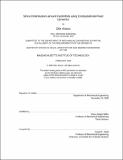| dc.contributor.advisor | Klaus-Jürgen Bathe. | en_US |
| dc.contributor.author | Aharon, Ofer, S. M. Massachusetts Institute of Technology | en_US |
| dc.contributor.other | Massachusetts Institute of Technology. Dept. of Mechanical Engineering. | en_US |
| dc.date.accessioned | 2009-08-25T18:01:01Z | |
| dc.date.available | 2009-08-25T18:01:01Z | |
| dc.date.copyright | 2009 | en_US |
| dc.date.issued | 2009 | en_US |
| dc.identifier.uri | http://hdl.handle.net/1721.1/46382 | |
| dc.description | Thesis (S.M.)--Massachusetts Institute of Technology, Dept. of Mechanical Engineering, 2009. | en_US |
| dc.description | This electronic version was submitted by the student author. The certified thesis is available in the Institute Archives and Special Collections. | en_US |
| dc.description | Includes bibliographical references (leaf 108). | en_US |
| dc.description.abstract | This research describes the reciprocal influence between two foils, vertically and horizontally oriented, on each other for different gaps between them. Those cases are the focus part of a bigger process of lowering significantly the drag of a ship when hydrofoils are attached to its hull. The research results are based on CFD analyses using the ADINA software. In order to verify the CFD process, a comparison was made between analytical, experimental and ADINA?s results for a single foil. The chosen foil was the famous Clark-Y foil; however a correction to its geometry was made using the Unigraphics software. Using the corrected geometry with an analytical solution well detailed and explained, the results of the CFD model were compared to experimental and analytical solutions. The matching of the results and the obtained accuracy are very high and satisfactory. In addition, the research contains an examination of the results when one of the boundary conditions is changed. Surprisingly, it was discovered that the FREE slip condition along the foil is much closer to reality than the NO slip condition. Another examination was stretching horizontally the foil and checking the pressure distribution behavior. Those results met exactly the expectations. As for the main core of this research, both the bi-plane case and the stagger case were found to be less effective than using a single foil. The conclusion of those investigations is that using those cases a few decades ago was for a structural reason rather than stability or speed. Since this research is very wide but also deep in its knowledge, references and academic work, many future research works may be based on it or go on from its detailed stages. | en_US |
| dc.description.statementofresponsibility | by Ofer Aharon. | en_US |
| dc.format.extent | 108 leaves | en_US |
| dc.language.iso | eng | en_US |
| dc.publisher | Massachusetts Institute of Technology | en_US |
| dc.rights | M.I.T. theses are protected by
copyright. They may be viewed from this source for any purpose, but
reproduction or distribution in any format is prohibited without written
permission. See provided URL for inquiries about permission. | en_US |
| dc.rights.uri | http://dspace.mit.edu/handle/1721.1/7582 | en_US |
| dc.subject | Mechanical Engineering. | en_US |
| dc.title | Stress distributions around hydrofoils using computational fluid dynamics | en_US |
| dc.type | Thesis | en_US |
| dc.description.degree | S.M. | en_US |
| dc.contributor.department | Massachusetts Institute of Technology. Department of Mechanical Engineering | |
| dc.identifier.oclc | 426485414 | en_US |
